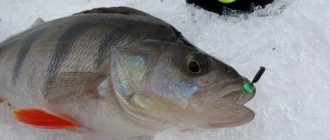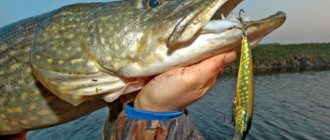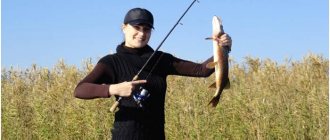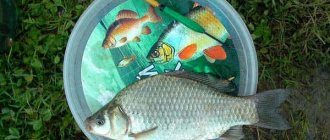How to choose a carp line for a beginner? That is, the most suitable one is specifically for catching carp (a cunning, intelligent and freedom-loving opponent). A record holder, not only in weight and heroic strength, but also in fierce resistance. What types of fish are suitable for carp fishing? Why do you need to take into account such characteristics of fishing line as color, thickness and stretchability? What to choose for marker and spod rods? The answers can be found in this article.
Varieties of carp lines
In order to understand the main question: “which fishing line is best for carp fishing?”, it is advisable for beginners to know (at least to broaden their horizons) what types of fishing lines exist (in general) on the fishing market? What are they intended for, individually? Since, for example, even the most important advantage of one type of fishing line (under strictly defined carp fishing conditions) can easily turn into a significant disadvantage - under any other fishing conditions. But we will not dive deeply into this topic, and will consider only those options that can be called “true carp” fishing line.
Monofilament line
In most cases, this is a classic version of nylon fishing line, which is very popular in many other types of fishing (float, feeder, and so on). By the way, the material from which it is made (that is, nylon) was developed in 1937 specifically for fishing gear. The main difference between carp monofilament (from other variations) is the diameter. It is imperative to take into account that carp is a powerful rival that incredibly loves freedom, so it will resist like a rebel until the very last moment.
The ideal choice of monofilament fishing line for a beginner is 0.3 mm. Of course, it will not have super-flight qualities (for example, due to such characteristics as strong/extensibility). But, you see, there’s no point in even trying for a novice carp angler to immediately cast the gear further than 100-150 meters. In addition, optimal stretchability “forgives” many mistakes, especially when landing carp on the shore, perfectly absorbing unpredictable and quite powerful jerks.
Braided cord
Despite the fact that “braid” (other names: “thread”, “lace”) has many excellent characteristics: strength, wear resistance, “flight” (due to the minimum diameter), etc. However, it also has a “other side of the coin” - it is not only high cost (a kind of “payback” for the highest quality of materials), but also absolute non-stretchability.
It is for this reason that using braided cord as the main line for beginners is strictly NOT recommended! Because even seasoned carp fishermen who love extreme sports and lots and lots of thrills, when fishing for carp with the help of braid, they very often have troubles. At least in 30% of cases. BUT (!) for a marker rod – there is no better alternative! This will be discussed below.
Fluorocarbon
Fluorocarbon fishing line currently ranks 1st in popularity in the world of carp fishing! Initially, fluorocarbon was created by the Japanese (in 1971) exclusively for the specific needs of the oil industry. Its key advantages:
- increased resistance to aggressive environments (not only chemical, but also physical);
- high resistance to temperature changes (ranging from - 40°C to +160°C);
- minimal “aging” under intense exposure to ultraviolet rays;
- “exorbitant” wear resistance (wears off very slowly, does not “swell” in water, etc.).
How to make a choice
First you need to decide which company to choose. This will lead to envy and price. It is better to choose products from well-known manufacturers, but you should only buy them in trusted stores. Otherwise, you can easily buy a fake for a lot of money.
Experienced carp fishermen know that soft tensile fishing lines are stronger in knot joints and allow them to absorb jerks when fishing for large carp or carp. But at the same time, soft fishing lines are not stable for fishing on rocky or shell bottoms and often break when caught. Moreover, carp like to hide in snags after they feel that they have been caught.
Braid, monofilament, fluorocarbon
And here the question arises about the balance of all the gear, that it is necessary to find the balance of all components - fishing line, rods, sinkers, feeders. For a soft rod, a stiff line is suitable. For hard - soft. Here you can again think about the topic: braided or monofilament, which is better. This dilemma constantly arises for beginning carp anglers. Price often stands in the way of using braided wire.
The following advice can be given: for a fly fishing rod it is better to use a monofilament, but for a bottom tackle or feeder you will need to choose between monofilament or braid.
For short-distance fishing, feel free to use a monofilament with a diameter of 0.2-0.3. For casting to 35 meters and further, braided line is suitable.
For donkey fishing in snags, you definitely need to choose braided line. Although braid has one big drawback - it gets very tangled when casting.
For catching carp, braided line is most likely suitable; it is a stronger fish.
You should not use fluorocarbon as the main fishing line for carp fishing, as you are catching large fish. Fluorocarbon has less strength, especially at the knots, which is important when fishing for carp and carp. However, fluorocarbon can be used very well on leaders.
Correct color of carp line
Which color is best for carp fishing? And what does all this “color magic” mean? Is it really the modern carp’s favorite color, or do they “adapt” to the glamorous fashionista fishermen? It's actually quite simple. Bright fishing lines (colored pink, orange, yellow or other “acid” colors) are strictly (!) intended for night carp fishing . They are clearly visible in the dark, so the carp angler will be able to track the jerks of the trophy or adjust the next cast. For daytime carp fishing, it is necessary to select only “camouflages”, and best of all, the most transparent options (i.e. expensive, but very effective fluorocarbon).
Key parameters of fishing line for carp fishing
When thinking about which line is best to choose for carp, choose the diameter, use the appropriate shade, what its thickness should be and other related characteristics, you need to start from the conditions of the upcoming fishing.
Let's look at the main ones:
- Carp spend most of their time at depth; they feed from the bottom, which means that in order to deliver the bait to the depth, it must sink perfectly.
- When considering which shade of fishing line is optimal for catching carp, you should give preference to a range of shades that are as close as possible to the background of the water in the reservoir, because it has long been established that bright colors scare away this fish. The exception is a fishing line for carp of a red hue, and this is explained by the fact that the red color is absorbed in green water and such a fishing line or braid becomes inconspicuous.
- Another key parameter of the fishing line is the level of its breaking load. For this type of fishing, it is advisable to choose the thinnest model, but with the maximum permissible load.
Manufacturers often play it safe and put on the label a lower breaking capacity than it actually is. Therefore, when purchasing a fishing line for carp from a trusted manufacturer, know that it can withstand a significant load, usually 2-3 kg, than what is written on it.
Thickness (section) of fishing line for carp
The thickness of carp varieties of fishing lines (often used in carp fishing) ranges from 0.20 to 0.40 mm. What should a beginner choose? By and large, a lot here depends on how far you are going to throw the gear, and in what places you intend to fish (ordinary or difficult/“strong”). Thus, for long casts (over 130 meters), experienced carp anglers choose monofilament fishing line with a diameter of 0.26-0.28 mm. For short range (up to 130 meters) fluorocarbon – 0.35 mm cross-section. But for difficult carp fishing in snags or algae, use a “thicker” monofilament line with a thickness of 0.40 mm. The recommended option for a beginner karpolov is 0.3 mm, as mentioned above.
Tensile strength (breaking load)
In the process of choosing the most suitable option for carp fishing line, in addition to color and thickness, you need to pay attention to such a parameter as breaking load (extensibility). This characteristic indicates the weight of the fish that the fishing line will support. These numbers are very important, so companies often indicate them directly on the reels. Domestic producers, in our usual kilograms, foreign companies (according to the standards of Great Britain - the Homeland of carp fishing ) - in “libs” (lb).
To make it easier for you to navigate, take note that one English “libs” - 1 lb is equal (approximately) to our 450 grams. When choosing your first fishing line on your own, don’t worry - you can’t go wrong with its strength. Since both manufacturers indicate numbers with a “reserve”, and the “rod + reel clutch” combination normally “dampenes” all the jerks of the caught carp.
Plus, according to the laws of physics, the pressure on a small hook will always be much less than the weight of the fish. In general, don’t worry, act boldly!
Reels
Carp equipment includes a reel. For carp gear, there are a number of specialized spinning reels that differ in price, spool capacity and some design features. The first detail that you should pay attention to when buying a reel for carp fishing is the presence of a baitrunner.
Tips for fisherman: Which rod to choose for carp fishing - Answers for beginners
This design allows, after casting, to change the clutch adjustment from the “tightened” position to the “free spool movement” position with one movement. This is necessary so that after a bite, a large fish does not drag the rod into the water. When the fish is hooked and needs to be fished out of the reservoir, the baitrunner, after the first skeins of the reel handle, returns the spool to a tight motion so that the line does not come off and allows the fish to be comfortably delivered to the landing net.
In this article we will look at how to mark fishing line at home. We raised this topic in a previous article about catching sawfish , and it’s time to talk in more detail.
Features of unwinding and winding
How many meters of carp line should be spooled onto the spool? How much should a beginner buy? According to the advice of wise carp anglers, for the very first season in their lives (under the guidance of an experienced mentor), it will be enough for beginning carp anglers to purchase 250-300 meters. But next season, when you are ready to go into battle on your own, multiply this number by four! Taking into account the competent use of at least a couple of working carp rods , as well as a “marker” and a “spod”. That is, you will already need 1000-1200 meters.
Fishing wisdom - how to save money?
You may have already noticed that the forest capacity of carp reels is quite large. Moreover, the steeper the model, the higher this characteristic will be - 300, 450 and even more than 500 meters. Of course, out of deep respect for the carp, the spool can be filled completely - exclusively with branded fishing line. However, the fish will not be offended by us if we save our budget a little using a cunning trick called “backing”.
What it is? - you ask. In simple words, backing is a kind of “backing” / “lining” located at the base of the spool, directly under the main line. Some fishermen “construct” it from thick, harsh threads, others from electrical tape, but most use old fishing line left over from last year’s season, or buy cheap ones.
By the way, many companies have already taken this nuance into account, therefore, they include special stands in their product packages. The best option is for beginners on their first trip in life. (see photo below for how they look)
“Store” backing for SHIMANO reels
Braided line for carp fishing
Braided line in carp fishing also creates direct contact with the fish both when hooking and when retrieving. As soon as the braided angler takes the triggered rod into his hands, he feels every movement of the carp desperately struggling at the opposite end. Monofilament fishing lines, due to their stretchability, hide such details of fishing, making it less bright and even a little bland. Therefore, for those fishermen who want to enjoy every moment of fishing, every second of a fierce fight with carp, we can safely recommend using braided fishing line.
"braid" wins
In addition to the aesthetic aspect of fishing, braided fishing line outperforms monofilament fishing line in practical terms. The lack of stretchability of the “braid” allows us to suppress the jerk of the fish from the first seconds of fishing and force it to move in the direction we need. High-quality monofilament line has an elongation of approximately 15%, so even with the drag fully tightened and your hand on the spool at a distance of 100 m, a carp can take more than 10 m of line - and this despite the fact that you have not given it a single centimeter from the spool! In case of excessively forced fishing, monofilament line, which has a lower breaking load than braided line, can simply break.
Nevertheless, the stretchability of monofilament lines will play into the hands of beginning carp anglers, since it smooths out numerous mistakes when fishing. When fishing with a braided line, a tightened clutch, an awkward or excessively sharp movement of the rod, a thin wire hook on delicate equipment that easily unbends under pressure, or the slightest slack in the line - and the fish is guaranteed to escape. Many anglers have probably lost a few fish when switching from monofilament to braided line. At such moments, thoughts begin to creep in about inappropriate installation, an insufficiently sharp hook, etc. But it’s all a matter of habit - you just need to adapt to fishing with a braided line.
Successful fishing with a braided line
It is important to use fairly soft parabolic rods. This is true, since a soft, well-played top not only forgives mistakes when playing, but also gives an unforgettable storm of emotions from a battle with a worthy opponent. That is why it is advisable to have two sets of rods: for fishing from a boat/ship using braided fishing line and for working at long distances with monofilament fishing line. When fishing is carried out imported, we simply do not need the additional power of long-range guns, since we can deliver equipment to any desired distance without any problems. If financial capabilities do not allow you to maintain two sets of fishing rods, then for fishing with braided fishing line you need to adapt the rigs: eliminate hooks made of thin wire from your arsenal, switch to using large-sized hooks that dig into the fish’s lip more reliably, as well as using heavier ones sinkers that improve self-notching.
Carp line for marker rod
To effectively scout the bottom of a reservoir using a marker rod, you must use a strictly braided cord! The thing is that it is the braided line (due to its non-stretchability) that is capable of “transmitting” in the smallest detail any vibrations or shocks to the rod blank, thereby allowing the structure of the bottom to be recognized as accurately as possible.
Monofilament fishing line “extinguishes” all sensations several times at once! The most popular diameter of carp line for a marker (among experienced carp anglers) is 0.18 mm. Other popular sizes (mainly among ordinary carp fishing enthusiasts): from 0.15 mm (but only branded/expensive models) and up to 0.25 mm (possibly budget products from “folk” companies).
It is definitely worth noting that seasoned Karpolovs prefer “floating” models of braided cords in their work. Promoting the quick and easy “surfacing” of the float, which greatly saves time during numerous depth measurements.
Types and classification of fishing line
Let us immediately note that we will not consider braid, which is popular when fishing for carp on a feeder, since it has low elongation and large individuals will tear it without any problems. As a rule, nowadays it is customary to classify carp fishing line according to the material from which it is made.
So, in our rating of models, it is certainly worth including modifications made on the basis of the following materials:
- Nylon has long proven itself to be the best. It is used when fishing for carp, carp and other types of fish; it stretches perfectly and has the proper strength with minimal thickness. Perhaps its only pronounced drawback is its rather rapid erasure;
- polyethylene is used to create wicker equipment. This line for carp fishing is popular among fishermen due to its high reliability and low level of elongation; as a rule, it has a small diameter. The components for its manufacture may be different, but they are all united by a special method of impregnation;
- nylon is not as popular nowadays as it was 10 years ago, as it is quickly destroyed by exposure to ultraviolet radiation and significant loads.
Initially, this material was developed for oil producing organizations. It has good characteristics and is resistant to a variety of physical and chemical loads. Perhaps today there is no fishing line better than this, it does not change its own parameters at temperatures from -40 to +150 °C, such tackle is almost impossible to “kill”, it is not visible in the water, which is very important when fishing for such fish.
What is better to choose for a spod rod?
Unlike the previous option, for a spod (rocket) fishing rod you can use: both fishing line (with a diameter in the range of 0.28-0.30 mm) and braid (with a cross-section from 0.18 to 0.20 mm). However, if optimal accuracy is very important to you when baiting the future fishing point, then know that when using a rigid braided cord, there are often “blows into the clip.” That is, according to the laws of inertia, the bait rocket can bounce far from the splashdown site. Even a few meters back, it is directly proportional to the distance (and, accordingly, the strength) of the cast.
The best winter fishing lines for jigs
Salmo Ice Power
Rating 4.9
If other representatives of the category were entirely all-season fishing line models, then Salmo Ice Power is a purely winter monofilament for those who like to fish with jigs. Ideally calibrated throughout the entire unwinding (with an accuracy of a thousandth of a millimeter), it provides guaranteed breaking stress values specified in the manufacturer’s reports. Actually, with a range of diameters from 0.08 to 0.30 millimeters, the stress values change in the range of 0.52-6.95 kilograms.
With Salmo Ice Power, no problems with freezing or water absorption were observed, which indicates a good water-repellent and protective function of the protective shell. The memory effect that is so disgusting to all fishermen is not observed. Zero stretch gives the line maximum sensitivity, so users can clearly control the fishing process and the moment of biting. Taking into account the low price (for 50-meter unwinding), “The Power of Ice” is the best choice among its peers.
Advantages
- low susceptibility to stretching, high sensory ability;
- reliable protection of the thread from moisture absorption and freezing;
- significant threshold of withstand voltages;
- low price.
Flaws
- not identified.
Berkley FireLine Micro Ice Fused Original
Rating 4.8
A line of German fishing lines suitable for any fishing conditions: both winter and summer. It is distinguished by a high degree of quality and transparency, which allows you to catch even the most cautious predator. Coupled with minimal stretch, Berkley FireLine Micro Ice Fused Original offers consumers high sensitivity, which makes it possible to more precisely control the process of wiring and biting.
The breaking load of the fishing line (depending on the diameter) varies between 1.5-4.8 kilograms. Thus, despite the commitment to light baits, FireLine Micro Ice Fused Original allows you to catch not small fish. Its prey is often perch and pike, and sometimes pike perch and ide are caught. At a relatively low price, this is one of the best offers in the segment at the moment.
Advantages
- complete invisibility in water;
- acceptable price;
- good load capacity;
- high sensitivity due to low extensibility.
Flaws
- not detected.
Fishing line for mounting a carp leash
Most likely, even if you are a beginner, you still understand that carp fishing is a special event that requires maximum seriousness during preparation (especially in carp fishing). Therefore, to install leashes, it is necessary to use materials that will not only be optimally strong (reliable), but also elastic (absolutely not injuring the carp’s lips).
On the other hand, a carp leash should be: both invisible (i.e., quite thin), and, at the same time, wear-resistant (i.e., normally protected from various damages). Therefore, for most tactics and techniques, the most suitable option is “soft” braided cord models. When fishing for carp in difficult places, use braided line in a special/protective casing.
Other combinations are possible, for example, high-strength (and relatively stiff) braided cord, but (!) in combination with soft fluorocarbon.
Leash for crucian carp with fishing line for feeder fishing
In feeder fishing for crucian carp, leashes of 0.12 mm - 0.14 mm and a length of approximately 40-50 cm are used. Of course, in certain conditions, the length of the leash will need to be either shortened or made longer.
Tips for fisherman: Which boilies are best for carp in summer - All the nuances
Leashes for crucian carp in feeder fishing can be made of nylon (monoline), they are softer, more elastic and have stretchability, thereby additionally absorbing jerks of the fish. Fluorocarbon leashes are stiffer, have minimal stretch, but are less noticeable in the water.
So if we fish in clear water and relatively shallow depths, fluorocarbon leashes will be more appropriate. If fishing for crucian carp occurs at depth and in muddy water, then you can use monofilament. But these are kind of general recommendations.
Carp is rightfully considered the most delicious and healthy type of river fish. Its fillet has a subtle sweetish taste. In terms of taste characteristics, carp meat is most similar to beef. Therefore, in winter, many fishermen try to catch a valuable trophy in the form of a 10-kilogram carp.
Recommendations for storage and maintenance
And finally, we bring to your attention some useful tips to ensure that your carp fishing line serves you for a couple of seasons in a row.
- When using fluorocarbon, try to get a special line care fluid. This product will allow you not only to reduce its wear and tear, and also to clean it from “sticky debris” (for example, small particles of algae), but also to significantly increase the casting range (by reducing the friction force).
- In your free time (from fishing), keep your spools in boxes and cases. As far as possible from direct sunlight or heat from apartment radiators / fireplaces.
- How often should you change carp fishing line? Be sure to check its condition after each (!) fishing trip. If there is damage (roughness or abrasions felt by the thumb and forefinger when pulling out), feel free to cut off these couple of meters (usually they are the last ones). In the middle of the season, the line can be rewound back and forth. And next year – let her go to “backing”.
Other materials on our website:
- Shockleaders and leadcores for carp - what are they and why are they needed?
- How can a beginner choose the right reels for carp fishing?
- Carp leader materials (types, properties, characteristics)
Publication author
offline for 10 months
Storage and operation
Not everyone pays attention to this point, but in vain, since for the durability of the part you need to know how and where the fishing line for carp fishing should be stored correctly.
After fishing, you need to make sure that the thread dries thoroughly. You cannot immediately put the reels in their cases after pulling out the fishing line, as some do.
It is also important to ensure that the element is not exposed to sunlight. If there is such a possibility, then the spools must be covered even during the fishing process. If it is noticed that there is damage somewhere, these places should be removed immediately.











